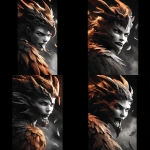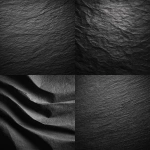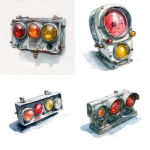Explore the Best AI Image Gallery

Quantum Creativity: Where Art Meets Quantum Computing
The realm of creativity is on the cusp of a profound transformation, driven by the exponential power of quantum computing. This emerging technology, with its ability to process information at an unprecedented scale, promises to revolutionize artistic expression, design, and innovation across various creative disciplines.
Unleashing Artistic Potential
Quantum computers offer artists and designers a new set of tools to explore and manipulate complex concepts in ways never before imagined. Imagine:
- Generative Art on Steroids: Algorithms powered by quantum computing can generate stunningly intricate and original artwork, pushing the boundaries of traditional artistic styles.
- Interactive Quantum Installations: Immersive art experiences that respond to viewers presence and emotions in real time, creating a truly dynamic and personalized engagement.
- Personalized Music Composition: Quantum algorithms can analyze individual preferences and create unique musical pieces tailored to each listeners taste.
Design Reimagined
The impact of quantum computing extends far beyond the realm of fine arts. In design, it holds the potential to:
- Revolutionize Product Design: Quantum simulations can help designers optimize product structures for maximum efficiency and performance.
- Accelerate Material Discovery: By analyzing vast datasets, quantum algorithms can identify novel materials with unique properties, leading to groundbreaking innovations in various industries.
- Create Adaptive Architectural Structures: Buildings that can respond to environmental changes and user needs, optimizing energy consumption and enhancing the living experience.
Ethical Considerations
While the possibilities are undeniably exciting, its crucial to address the ethical implications of quantum creativity:
- Bias in Algorithms: Quantum algorithms trained on biased data can perpetuate existing societal inequalities. Ensuring fairness and inclusivity in AI development is paramount.
- Ownership and Authorship: Who owns the copyright to artwork generated by quantum algorithms? This raises complex questions about artistic ownership and intellectual property rights.
- Accessibility and Equity: The high cost of quantum computing could create a digital divide, limiting access to these transformative technologies for individuals and organizations with limited resources.
Future Trends
The intersection of quantum computing and creativity is still in its early stages. Here are some potential future trends:
- Quantum-Powered Creative Education: Integrating quantum concepts into art and design curricula, empowering the next generation of creative innovators.
- Collaborative Quantum Creativity Platforms: Online platforms that foster collaboration between artists, designers, and quantum computing experts, enabling groundbreaking artistic endeavors.
- Quantum-Enhanced Immersive Experiences: Virtual and augmented reality experiences powered by quantum computing, blurring the lines between physical and digital realities and creating truly transformative artistic expressions.
As quantum computing continues to evolve, its influence on the creative industry will only intensify. By embracing this powerful technology responsibly and ethically, we can unlock a future where art, design, and innovation reach new heights of creativity and impact.











](https://images.ai-img.art/thumbnails/150/3c5dc62bba83cc9919c20ebfec8430d31e821cef586a2753dd85ef26d77d480a.webp)

](https://images.ai-img.art/thumbnails/150/8c320ce9aefbbb5b9ec5fd4e1d0fba7388f0fff5b6c2e2f14077cad3008f291d.webp)
](https://images.ai-img.art/thumbnails/150/1accb5453f2335686b162f0a879c7ce73a18516a33868f214a16bdaf95beeb5a.webp)

](https://images.ai-img.art/thumbnails/150/1d7b3a908141474d50d90721c394db29c0cb5404d685ae70ea60430c18e905b7.webp)






](https://images.ai-img.art/thumbnails/150/3e8c063b4357fc743a3c6e49a3145ee31b2dcecc018c38d2db8f97bf3e3fda3f.webp)